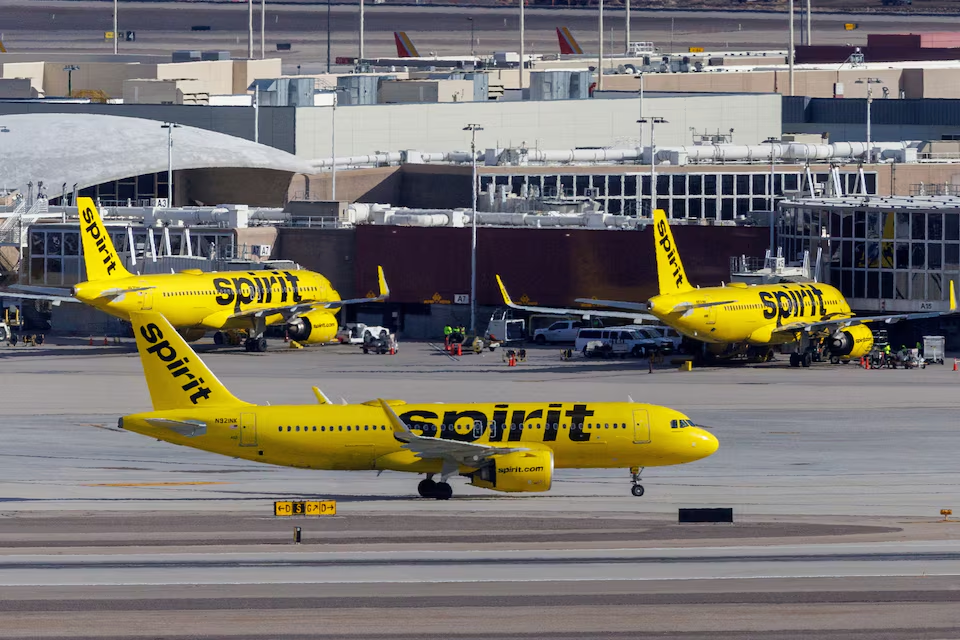A Turbulent Time for Spirit Airlines
Spirit Airlines, known for its bright yellow planes and ultra-low-cost model, is facing a stormy period. Just months after emerging from bankruptcy, the airline has hired advisers to explore strategic options as its financial restructuring efforts have fallen short. As someone who’s flown Spirit for its unbeatable fares (and survived the no-frills experience), I know the airline’s value to budget travelers—but its future is now uncertain. Let’s unpack the challenges, the options on the table, and what this means for passengers and investors.
The Backstory: Spirit’s Financial Struggles
Spirit Airlines has been grappling with financial woes for years, worsened by the COVID-19 pandemic, failed mergers, and operational hurdles. Its recent bankruptcy filing in November 2024 was a bold move to reset, but the airline’s recovery hasn’t gone as planned. Weak domestic demand and dwindling cash reserves have raised serious doubts about its survival.
A Bankruptcy That Didn’t Solve Everything
Spirit emerged from Chapter 11 in March 2025, shedding $795 million in debt and securing $350 million in equity. Despite this, the airline reported a $1.2 billion net loss in 2024, with operating expenses up 18%. The restructuring, while a step forward, hasn’t delivered the sustainable future Spirit hoped for.
The Failed JetBlue Merger
A proposed merger with JetBlue Airways, blocked by a federal judge in 2024, was meant to bolster Spirit’s finances. The ruling, citing higher fares for consumers, left Spirit to fend for itself. As a frequent flyer, I remember the buzz on X about how this merger could’ve saved Spirit’s low-cost model—sadly, it wasn’t to be.
Operational Challenges
Spirit’s fleet has been hit hard by Pratt & Whitney engine issues, grounding an average of 25 aircraft in 2024. This has slashed capacity and revenue, with repairs taking over 300 days per engine. These setbacks, combined with a competitive market, have made profitability elusive.
Why Spirit Hired Advisers
On August 22, 2025, the Wall Street Journal reported that Spirit enlisted financial adviser PJT Partners and consulting firms FTI and Seabury Airline Strategy Group to explore strategic options. This move signals a critical juncture as the airline fights to avoid another financial tailspin. The advisers are tasked with finding a path forward—whether that’s restructuring debt, selling assets, or exploring partnerships.
The Role of PJT Partners
PJT Partners, a leading financial advisory firm, specializes in navigating complex restructurings. Their involvement suggests Spirit is considering significant moves, possibly including debt refinancing or a sale. Their expertise could be a lifeline for the struggling carrier.
FTI and Seabury: Operational Expertise
FTI and Seabury Airline Strategy Group bring deep aviation knowledge. They’ll likely analyze Spirit’s route network, cost structure, and customer offerings to identify efficiencies. This could mean cutting unprofitable routes or rethinking the airline’s ultra-low-cost model.
A Response to Market Pressures
Spirit’s advisers are stepping in amid a tough market. Competitors like Frontier and Southwest are expanding, while legacy carriers like Delta offer “basic economy” fares that rival Spirit’s prices. Posts on X reflect the sentiment: “Spirit’s fares aren’t even that cheap anymore—why fly them?”
Spirit’s Revamp Efforts: What Went Wrong?
Spirit’s post-bankruptcy strategy aimed to shift from a bare-bones model to a more premium experience, but the results have been lackluster. The airline introduced fare classes like Premium Economy and “Big Front Seat,” eliminated some fees, and promised free Wi-Fi for loyalty members. Yet, these changes haven’t translated into profits.
The Premium Push
Spirit’s attempt to mimic legacy carriers like Delta with premium offerings was bold but risky. As someone who’s flown their Big Front Seat (surprisingly comfy!), I appreciated the upgrade, but many budget travelers want rock-bottom fares, not extras. This shift may have alienated Spirit’s core customer base.
Persistent Losses
Despite cost-cutting and asset sales, Spirit’s cash burn remains high. Moody’s and Fitch downgraded the airline in August 2025, citing “higher than expected cash burn” and a “high likelihood of near-term default.” The airline’s $902 million liquidity isn’t enough to offset its $1.6 billion post-emergence debt.
Leadership Changes
The departure of CEO Ted Christie in 2025 and the appointment of Dave Davis, a turnaround expert from Sun Country Airlines, signaled a new direction. Davis’ $4 million signing bonus raised eyebrows, but his experience could help. Still, leadership transitions add uncertainty, as noted by analysts on X.
Strategic Options on the Table
With advisers onboard, Spirit is exploring several paths to stabilize its finances and operations. These options range from incremental changes to drastic measures, each with its own risks and rewards.
Debt Refinancing
Spirit faces $1.1 billion in Loyalty Notes due in September 2025 and $500 million in convertible notes due in May 2026. Refinancing these could buy time, but high interest rates and investor skepticism make this challenging. Advisers like PJT Partners are likely exploring creative financing solutions.
Asset Sales
Spirit has already sold 25 aircraft, generating $419 million in net cash. Selling more assets, like its new Dania Beach headquarters or airport gate slots, is an option. However, this could limit future growth, as one X user noted: “Selling planes is like selling your car to pay rent—temporary fix.”
Partnerships or Alliances
Spirit’s bankruptcy plan hinted at exploring joint ventures or alliances, a rare move for ultra-low-cost carriers. Partnering with a larger airline could provide financial stability, but it risks diluting Spirit’s brand. Fans on X are speculating about a tie-up with Southwest, though nothing’s confirmed.
Potential Sale or Merger
A full sale or another merger attempt is possible, though the failed JetBlue deal makes this tricky. Advisers may explore buyers willing to absorb Spirit’s debt for its valuable Airbus fleet. The market’s watching closely, with shares dropping 14.6% after the WSJ report.
Comparing Spirit’s Strategy to Competitors
Spirit’s challenges aren’t unique—other low-cost carriers face similar pressures. Here’s how Spirit stacks up against Frontier and Southwest:
| Airline | Key Strategy | Financial Health | Strengths | Weaknesses |
|---|---|---|---|---|
| Spirit Airlines | Premium offerings, cost-cutting | $902M liquidity, $1.6B debt | Young fleet, low fares | High cash burn, engine issues |
| Frontier Airlines | Ultra-low-cost, route expansion | Stable, profitable | Strong leisure market, efficiency | Limited premium offerings |
| Southwest Airlines | Hybrid model, customer loyalty | $8B liquidity, low debt | Brand loyalty, operational reliability | Higher fares than ULCCs |
Pros and Cons of Spirit’s Approach
Pros:
- Young, fuel-efficient Airbus fleet reduces fuel costs.
- New leadership with turnaround experience.
- Premium offerings could attract higher-paying customers.
Cons:
- Shift to premium model risks losing budget travelers.
- High debt and cash burn threaten liquidity.
- Engine issues and capacity cuts limit revenue.
Spirit’s pivot to a Delta-like model contrasts with Frontier’s commitment to ultra-low-cost and Southwest’s focus on reliability. As a traveler, I’ve noticed Southwest’s free bags keep customers loyal, while Spirit’s fees often spark complaints on X.
What This Means for Travelers
For passengers, Spirit’s uncertainty raises questions about bookings, fares, and service. CEO Dave Davis assured employees in a memo that no immediate shutdown is planned, and travelers with tickets are safe for now. However, changes are coming.
Booking with Confidence
Spirit’s operations continue as normal, so booked flights should proceed without disruption. For peace of mind, book through platforms like Google Flights to compare options or check Spirit’s status on FlightAware. I always double-check airline news before booking budget carriers.
Fare and Service Changes
Expect Spirit to tweak its fare structure, with more focus on premium options like Big Front Seat. Free water and snacks are a nice touch, but fares may rise as Spirit chases profitability. X users are already grumbling: “Spirit’s not cheap anymore—what’s the point?”
Loyalty Program Updates
Spirit’s Free Spirit program is being simplified, with free Wi-Fi and priority boarding for members. If you’re a frequent flyer, consider the Free Spirit Travel More World Elite Mastercard for perks. I’ve used loyalty points to offset Spirit’s fees—it’s a lifesaver.
People Also Ask (PAA) Section
What is happening with Spirit Airlines in 2025?
Spirit is exploring strategic options after its restructuring failed to ensure profitability. Advisers like PJT Partners are helping navigate debt, asset sales, or potential mergers amid weak demand and high costs.
Why did Spirit Airlines file for bankruptcy?
Spirit filed for Chapter 11 in November 2024 due to years of losses, a failed JetBlue merger, and engine issues grounding planes. The airline emerged in March 2025 but continues to struggle financially.
Is it safe to book flights with Spirit Airlines?
Yes, Spirit is operating normally, and booked flights are unaffected for now. Monitor updates via Spirit’s official site or news outlets like Reuters.
What are Spirit Airlines’ strategic options?
Options include refinancing $1.6 billion in debt, selling assets like aircraft or real estate, forming alliances, or pursuing a sale. Advisers are exploring all paths to stabilize the airline.
FAQ Section
Q: Why is Spirit Airlines struggling financially?
A: Spirit faces high debt, engine-related capacity cuts, and weak domestic demand. Its 2024 $1.2 billion loss and failed JetBlue merger have worsened its cash crunch.
Q: Who are Spirit Airlines’ new advisers?
A: Spirit hired PJT Partners for financial advice and FTI and Seabury Airline Strategy Group for operational expertise to explore debt refinancing, asset sales, or partnerships.
Q: Where can I track Spirit Airlines’ news?
A: Follow Reuters, Bloomberg, or @aviationbrk on X for updates. Spirit’s investor relations page on spirit.com also provides official statements.
Q: Will Spirit Airlines shut down soon?
A: No immediate shutdown is planned, but Spirit has raised “substantial doubt” about its survival without more cash. Travelers should book with caution and monitor news.
Q: What are the best tools for booking Spirit flights?
A: Use Google Flights or Kayak to compare fares. Check Spirit’s site for deals or join the Free Spirit program for perks.
The Road Ahead for Spirit Airlines
Spirit Airlines is at a crossroads, with its bright yellow planes symbolizing both its bold identity and its precarious future. The hiring of advisers like PJT Partners shows a commitment to finding a way forward, but the challenges are steep—high debt, engine issues, and a crowded market. As a budget traveler, I’ve always appreciated Spirit’s low fares, even if the experience felt like surviving a budget boot camp. Whether through refinancing, asset sales, or a new merger, Spirit’s next moves will shape its fate. For now, keep an eye on Spirit’s official site or trusted news sources like Reuters for updates. What do you think Spirit should do to survive? Share your thoughts below—I’d love to hear from fellow travelers and aviation buffs!


